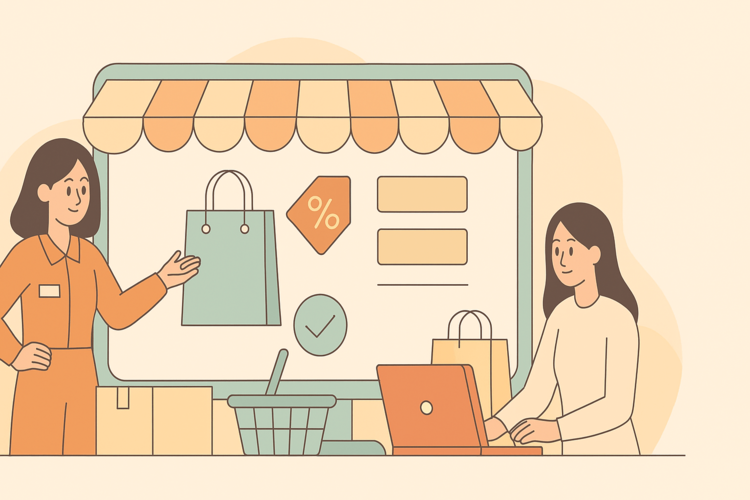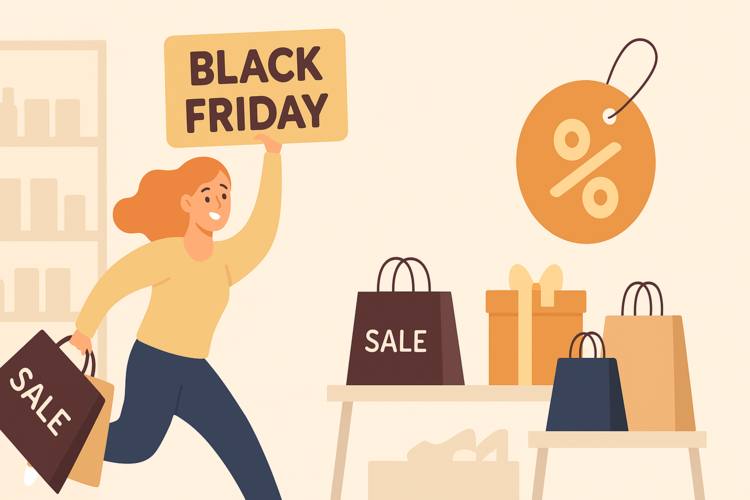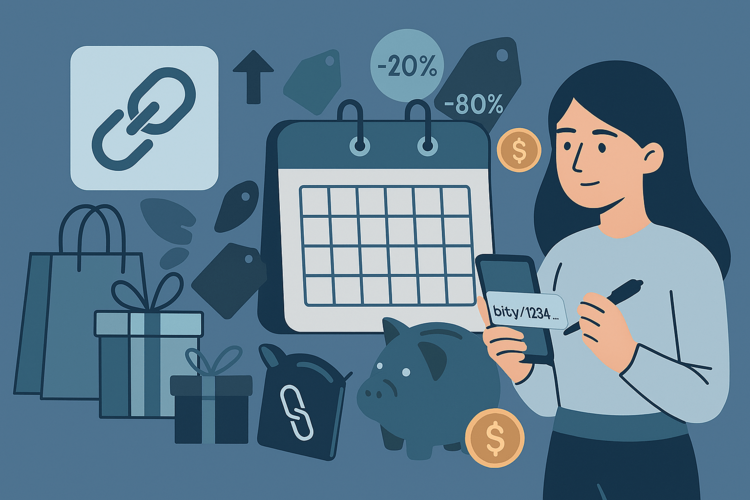Once a year, the world is hit by a wave of “minus 90%.” And even those who swore not to be swayed by marketing find themselves thinking: “Maybe I should get another monitor after all?”
Black Friday is the day when shopping becomes a sport. Once simply the start of Christmas sales in the US, it is now a global phenomenon that encompasses everything from electronics to VPS servers .
The history of Black Friday: from American chaos to global trend
The history of Black Friday did not begin with beautiful banners or “–90%”. In the 60s, in Philadelphia, the police called the day after Thanksgiving that because the city turned into a continuous traffic jam. People came in droves for discounts, parked on the sidewalks, ran between stores, and the city literally boiled. For the police, it was the hardest day of the year, so the name “Black Friday” sounded more like a sentence than a shopping holiday.
Black Friday is the best time to cut… links and spending!
Register on surl.li and control your links!
But retailers quickly realized that there was meaning in this chaos. They reinterpreted the term and presented it from another perspective - "black" as the color of profit, because in accounting, black is used to mark a positive balance. Since then, Black Friday has become not the curse of the traffic police, but the main day of sales.
Gradually, the tradition grew from a local phenomenon into a global event. First, Europe picked up the promotions, then Asia, and with the advent of large online platforms, the sale became a global holiday of discounts. Today, even Ukrainian companies plan their marketing strategies for this day, and Black Friday has finally become an international trend, covering more and more markets every year.
What Black Friday looks like today
The world has long since stopped perceiving Black Friday as just another day of supermarket madness. The format has changed along with shopping behavior: people have started buying more online, brands have become more sophisticated with prices, and shopping has become a competition of internet speed and attention to detail instead of chaos. Today, Black Friday is a completely separate season, with its own rules and habits.
Online sales
Lines outside stores have been replaced by lines… in shopping carts. Now, instead of standing outside the door at three in the morning, people are sitting at their laptops and trying to pay for the goods before someone else takes the last copy.
Amazon, Rozetka, Aliexpress, Apple Store, Steam — all simultaneously decorate their sites with “Black Friday Deals” inscriptions. The traditional players have been joined by those who were previously not associated with discounts at all: hosting, VPN, even software for developers. Everyone wants a piece of the traffic that is growing every year. Online Black Friday has turned into a huge digital market where you can find everything — from a kitchen knife to a year-long VPS for the price of a pizza.
Offline stores
Offline trade is also not giving up its positions, although it looks different now. There are queues, but they are more like a film set: people take out their phones and record every movement for TikTok or Instagram.
In some countries, the tradition of spending the night under the doors of stores is still alive - the doors open at 5 am, races for equipment start, and videos become trends. In Ukraine, there are fewer such scenes: most discounts are simultaneously available both online and in offline stores, so there is almost no point in standing in the crowd. Instead of "fighting for the TV", there is a calm viewing of prices on a smartphone.
Week or month of discounts — new format
Marketers couldn't hold out long. One day of sales quickly turned into “Black Weekend,” then into “Black Week,” and now some brands are launching “Black Month.” The total evolution of promotions — from a sprint to a marathon.
Such extended formats are convenient: buyers have more time to think, compare, and choose. But the same drive has disappeared when everything was decided within 24 hours and it felt like you were catching the last train.
This Black Friday is no longer panic shopping, but an entire season where patience, a cool head, and the ability to distinguish a real discount from a beautifully made-up one are important.
The Psychology of Discounts: Why We Are Attracted to Big Numbers
The psychology of discounts is a separate science, and it works better than any advertising. The human brain is programmed to respond to big, bright numbers: it saw “–80%” — and that’s it, the reward system is triggered. We don’t yet know what exactly they’re selling, but we already feel a pleasant tingling impulse: “oh, this is profitable, we have to take it.” It’s not about greed — it’s about brain chemistry.
When we see a big discount, the brain activates a dopamine response. It gives us the idea that we are not just spending money, but winning a small battle for justice. It is as if we caught the system red-handed and are now getting our money back. Marketers understand this perfectly well: that is why banners always say “–70%”, “–90%”, “for the sake of saving”, and not about the actual amount or real cost. Big numbers work faster than logic, because our brain sees not the product, but the emotion of saving.
Another interesting thing: even when a discount actually means “we returned the old adequate price,” people still react positively. The “before/after” effect triggers the impression of control — it seems to us that we have beaten the system. We get a dose of pleasure not from the purchase, but from the very idea that we “made it.” This is what makes Black Friday such a powerful cultural phenomenon: it plays not with our wallets, but with the deep mechanisms of the brain.
How brands are preparing for Black Friday
From the outside, it seems like brands just click the “–70%” button and launch a banner. In reality, Black Friday preparation is more like a long and nervous sprint, where marketing, analytics, warehouses, and finance work in pre-holiday DevOps mode. Below is what it looks like behind the scenes.

Promotion planning
No one comes up with a discount in two days. Businesses start preparing months in advance: teams calculate margins, determine limits, see which products can really be discounted, and which ones can simply be beautifully highlighted with a red price tag. Often, it's a whole math: which positions burn out quickly, what hangs in the warehouse, which products people hunt for every year.
Real preparation is not about designer banners, but about extensive analytics. Companies calculate the “sweet spots” of prices, test demand, and make sure that the product doesn’t go into the red after the discount. And only when the numbers match up does the discount become a reality, not a marketing fairy tale.
Advertising campaigns
If Black Friday is a holiday of bargains for shoppers, then for targeting experts and PPC specialists it is the Champions League final. All budgets are soaring, CPM is growing faster than yeast dough, and the competition for every click is fierce.
Brands are preparing dozens of advertising creatives, segmenting the audience, testing texts and banners to hit the main thing - FOMO. The task is one: to convince that now is the best moment, and today's discount is not "just another one", but the one that you can't miss.
Warehouse and logistics preparation
Online stores know perfectly well: the scariest thing during Black Friday is the phrase "the product is out of stock, but the money has been withdrawn." To prevent this from happening, warehouses prepare even before the start of the promotions: they check the balances, synchronize the databases, and form quick sets for shipment.
Logistics is turning into a well-coordinated machine: couriers, warehouses, and support services work synchronously, often in an enhanced mode. After all, if something breaks on this day, the brand risks not profit, but a reputational storm.
Pitfalls
Black Friday seems like a land of bargains, but it's easy to hide something hidden between the banners that you can't see at first glance. This is where marketing practices are at their most intense, and where shoppers often make impulsive mistakes. To avoid falling into the trap, it's worth knowing which schemes work every year.
Fake discounts
A classic of the genre: a week before the sale, the price quietly increases, and on day X it drops “by 70%.” On the screen, it’s a cosmic benefit, but in reality, the product costs exactly the same as it did last month. This isn’t even a scam, but a purely marketing sport — playing on the fact that few people remember the old prices. Therefore, before buying, it’s worth googling the price history or looking at price trackers — they quickly put reality back in place.
“Before/after” manipulations
Marketers know well: the brain perceives a big number better than a small truth. So the old price is written in small print, the new one in huge. Often the difference is minimal, but the visual contrast creates a “wow” effect. In addition, the red color on price tags is used for a reason - it enhances the sense of urgency. The result: even if the discount is symbolic, we instinctively think that we won.
Risks of online shopping
The more popular Black Friday becomes, the more scams appear around it. Phishing sites, copies of famous stores, fake promo codes - all this is found every year. Some fake sites are so similar to the original that you can distinguish them only by small details: a strange URL, a missing SSL certificate or contacts that lead nowhere.
Therefore, the golden rule is simple: double-check the URL, read reviews, look for real contacts, and don't enter your card where "something looks suspicious." Because sometimes "too cheap" is not a discount, but a warning.
How to keep buyers from losing their minds
Black Friday is the day when even rational people suddenly feel like RPG characters: bonuses, loot, “–90%” flash everywhere, and you want to click “take it all.” In order not to sit with an empty wallet and unnecessary purchases afterwards, you should act not like a hero of chaos, but like a person with a list and a cool head.
Plan ahead
To avoid buying something that you "suddenly need," it's worth making a list before the sale starts. Write down what you really need: equipment, tools, services, subscriptions. On the day of the sale, the brain goes into gambling mode - the same mechanism works as during bets or loot boxes. Therefore, improvisation often ends with the purchase of a third meat grinder, which "was very profitable." The list is your fuse.
Check price history
Not all “–70%” are the same. There are services that show how the price has changed over the months — and they save you from fake promotions. Sometimes the product simply returns to its previous price, but it is presented as a “super discount.” Checking the price history is the easiest way to distinguish a real benefit from marketing magic. It takes a minute, but saves hundreds of hryvnias.
Don't be fooled by the "latest copy"
The phrase “only one item left” is the most powerful trigger that plays on the fear of missing out. Often, this “last item” magically reappears a few hours later. It’s a pressure tool, not a fact. If the item is truly rare, Google will tell you very quickly. In any other case, act as if you still have time to think.
Don't buy on emotion.
A discount is not an excuse to buy something you never planned to. If you don't need the product on a regular day, it's unlikely to become a necessity on Black Friday. Keep a simple rule in mind: saving is not about "spending less," but about "not spending more."
Pay attention to details
During the rush, little things seem unimportant, but they are what shape the shopping experience. Check the delivery terms, shipping times, return policy, warranty, real reviews, who is sending the goods - the store or a third-party seller. It is especially important to look at the delivery date: sometimes a "good deal" product will arrive two months later, when there is no longer a need for it.
Paying attention to the little things is the best way to make Black Friday about profit, not disappointment.
Black Friday is not just a sale, it's a culture of consumption
Black Friday is no longer just a shopping day, but a cultural phenomenon. It shows how we think: who acts impulsively and who acts strategically.
For some, it's an opportunity to save money, for some, it's a stress test for the wallet, and for some, it's just a thrill.
But the real benefit is not in the percentage, but in the conscious choice. Buy what you need, not what flashes “-90%”.
Because Black Friday is not just about discounts. It's about the maturity of the consumer, who knows that every "good click" has its own price tag - even if it's written in small print.




